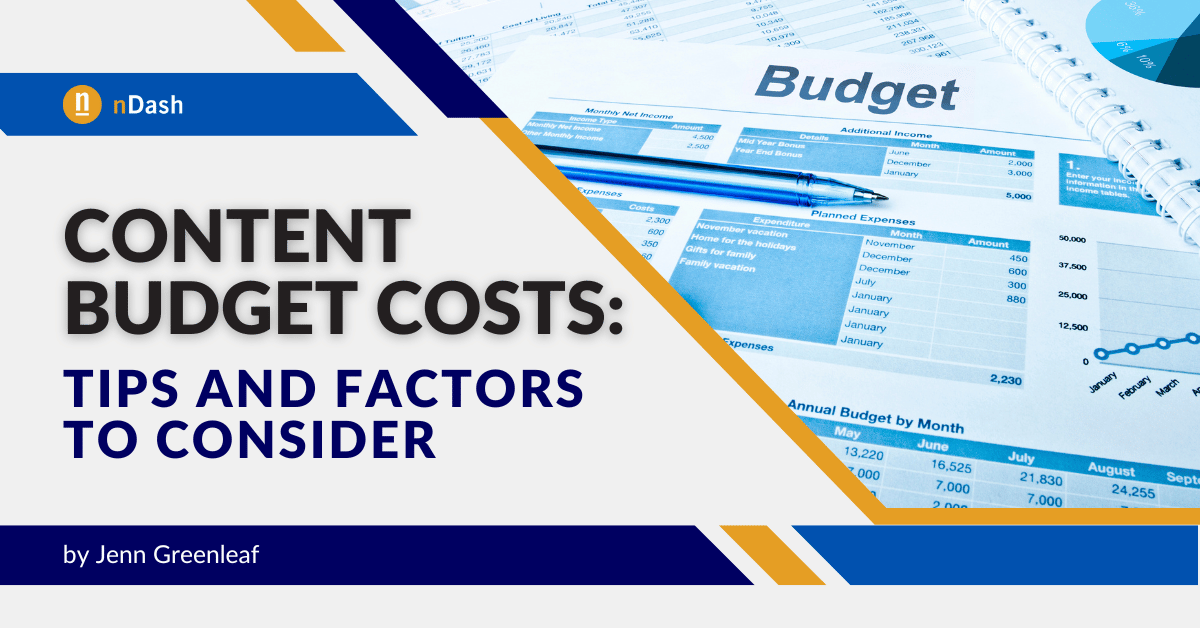Do you have questions about content budget costs? You’re not alone – with so many factors to consider, estimating and calculating can be a challenge.
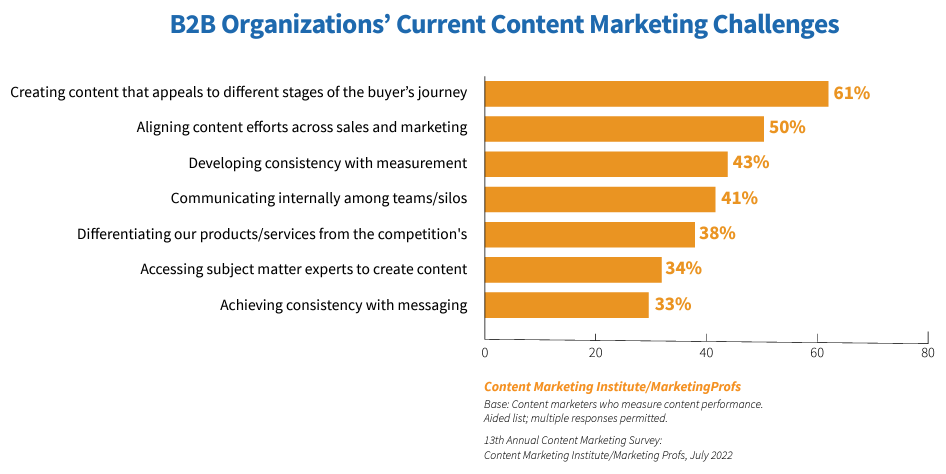
Source: 13TH ANNUAL INSIGHTS FOR 2023
Why Budgeting for Content Creation is More Important Than Ever
It doesn’t matter if you need social media posts or long-form blog content. A content budget must be in place first. According to data from Content Marketing Institute, 61% of organizations are challenged with creating content that appeals to different stages of the buyer’s journey.
What does that mean for content budgets?
Unfortunately, if you don’t know what content resonates, the likelihood of it producing the ROI you expect is low.
Content strategies play a pivotal role in how brands allocate their budgets. Look at the data table below from Semrush – 80% of very successful businesses have a documented content strategy. That data also shows that 79% of those businesses spend over 10% of their marketing budget on content.
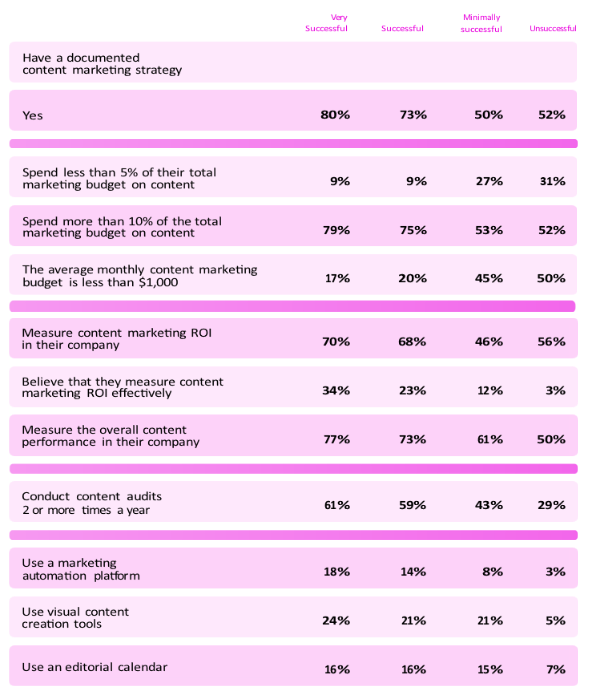
Source: The State of Content Marketing 2023 Global Report | Semrush
But that begs the question – how much should the content budget be? HubSpot conducted a survey revealing that 26% of marketers have quarterly budgets between $40,000 and $80,000. HubSpot conducted several surveys with a total of over 1,200 B2B and B2C marketers across the globe.
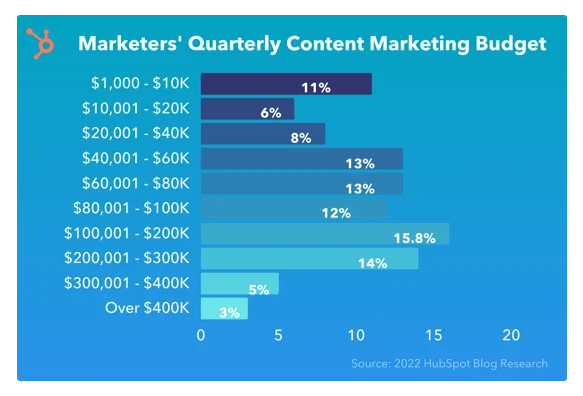
Source: What Will Content Planners Budget For in 2022 [HubSpot Blog Research]
Data aside, let’s take a deeper dive into the actual costs of content creation.
The Cost of Content Creation: Aligning Your Content Budget
Content needs change from year to year as businesses grow, economies shift, and consumer behaviors fluctuate. Despite this evolvement, one thing remains constant – the need for high-quality content that resonates with your target audience. However, the costs associated with content creation are often overlooked even though it significantly impacts a content strategy’s initiatives.
These costs go beyond inputting words into a document, recording interviews, or designing images. (Which, of course, only scratches the surface of what content strategies contain.) There’s a balance between generating high-quality content and ensuring those efforts are cost-effective.
Let’s look at what you can expect and what factors influence these costs:
Content Manager
Content managers do just that – manage content. No matter if your company needs to update its existing content or has plans to create new assets, someone has to manage that. You can expect the following salary ranges:
- Entry-Level: Base salaries average $51,141 annually.
- Mid-Level: Base salaries average $65,067 per year.
- Senior-Level: Base salaries average $103,188 yearly.
Some of the tasks content managers handle include content creation and editing, SEO, content scheduling, brand consistency, and more.
Content Strategist
Content strategists are responsible for the “how” behind content creation. These individuals develop and implement strategic plans for creating, organizing, and managing content across platforms. They align content with business objectives and target audience needs. Through research and analysis, they:
- Define goals
- Establish guidelines
- Create effective strategies
Base salaries range between $67,000 and $129,000 per year in the US.
Freelance and Agency Copywriters
Balancing what to pay freelance and agency copywriters is tricky. If you set your rates too high, you’ll use up your budget too quickly. Setting them too low jeopardizes content quality. There isn’t a “one size fits all” scenario for paying writers. Instead, you’re basing prices on their level of expertise. For example, a technology blog post could be $600 from a technical expert or $150 from a generalist. You can read more about this here: How Much Should You Pay Freelance Writers?
Proofreaders
While often used interchangeably, editing and proofreading are different roles. For example, proofreaders typically come in during the final stages of content production to catch errors an editor might have missed.
However, an editor takes a more comprehensive approach to reviewing and improving content. In addition to checking for grammatical, spelling, and punctuation errors, editors:
- Check for style and consistency
- Ensure the content aligns with the brand’s style guides
- Fact checks data and statistics
- Suggest improvements for clarity and readability
You can expect to see the following salary ranges for proofreaders:
- Entry-Level: Rates average $38,656 per year.
- Mid to Senior-Level Proofreaders: US base salaries range between $31,000 and $78,000 annually.
A content editor’s salary typically ranges between $32,000 to $82,000, depending on their experience.
Design Professionals
Even though you might have experience working with design tools, time might not be on your side. In that case, you’ll need someone to create blog images, social media imagery, infographics, and other assets to support your marketing efforts.
Here are some average rates you can expect for these types of tasks:
- Entry-Level: The average rate is between $22.00 and $36.00 per hour.
- Mid-Level: Hourly rates range between $26.00 and $40.00.
- Senior-Level: Hourly rates average $36.00 ($75,117 per year).
Social Media Management
Tools like Buffer are great for scheduling and posting on your social channels. But you actually have to have the content to post first. Unfortunately, this is a missed opportunity for brands whose audiences spend most of their time on social media, but there’s no time to create and manage posts. You can expect salaries to range between $50,000 and $98,000 annually.
How Quality Content Impacts Costs
I was scrolling through LinkedIn and came across this post by Ann Handley:
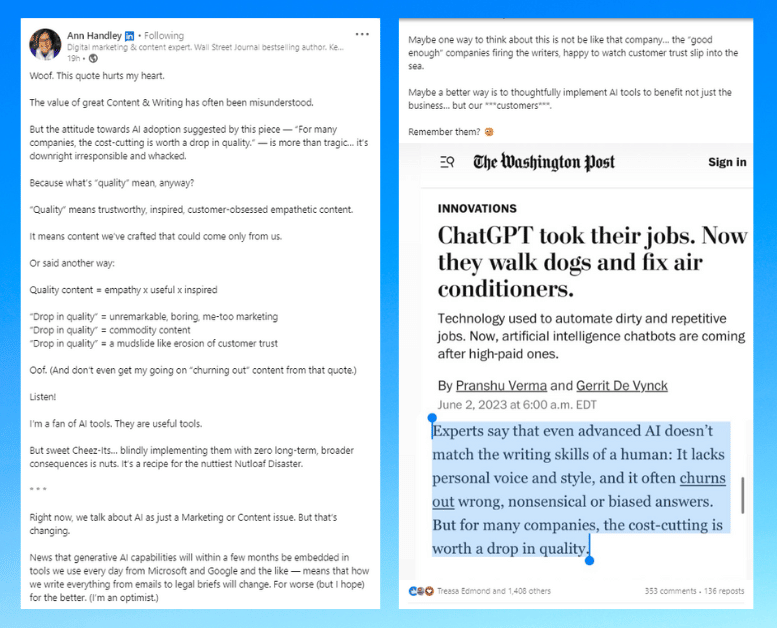
Source: Ann Handley on LinkedIn
Coincidence? I don’t think so.
Everyone is talking about content quality as ChatGPT and other AI tools evolve. As Ann points out – the customer should always be our first priority. That Washington Post article concerns me, as well. We shouldn’t cut content budget costs because that drop in quality impacts businesses in several ways.
Customer Acquisition
High-quality content that engages customers and provides value throughout the funnel does more than build trust. This content also helps businesses stand out as industry leaders and experts. As a result, that could lead to increases in:
- Increased brand awareness
- Higher conversion rates
- Increases in organic traffic
Customer Retention
We all want customers to return for more. But how can a brand retain customers if they’re not producing valuable content that addresses their needs? The simple answer is – they can’t. Building brand loyalty and producing high-quality content go hand-in-hand. It’s the best way to ensure your audience is engaged, educated, and satisfied.
Brand Image
Here’s another area where trust comes into play. Customers look for brands they can depend on to answer their questions, solve their problems, and consistently provide accurate information. By hitting on all of those points, brands can position themselves as trustworthy sources of information. Doing so enhances a brand’s:
- Reputation
- Credibility
- Perceived value
SEO Rankings
We’ve all read about how Google isn’t penalizing AI-generated content as long as it’s written for humans and follows E-E-A-T (expertise, experience, authoritativeness, and trustworthiness). So, looking back at the Washington Post headline Ann Handley shared. Are businesses risking a drop in SEO rankings when sacrificing quality to cust content budget costs?
The problem is that if the AI-generated content isn’t 100% accurate, it isn’t truly created for humans. That does more than ruin a brand’s reputation. It also negatively affects SEO efforts. To gain traction in search results, content must be:
- Well optimized
- Informative and accurate
- Engaging
Content Production Costs
Here, I’m not talking about producing blog posts and social media posts to promote them. I’m also talking about evergreen content. When producing something well-researched, well-written, and visually appealing, it tends to have a longer “shelf life” than a short current events-type blog post. Focusing on evergreen content does two things:
- Consistently provides value to your target audience
- Reduces the need to spend your budget on posting frequently
Promotion and Advertising Costs
High-quality content acts as a natural magnet for promotion and advertising. Valuable content has a greater chance of being shared, liked, and linked to by users, which can generate organic promotion through the following:
- Social media
- Word-of-mouth referrals
- Influencer marketing
Outsourcing vs. In-House Content Creation: Content Budget Considerations
For content creation, businesses have two options – outsourcing to freelancers or handling it in-house. Here are some factors to keep in mind when comparing outsourcing and in-house content creation from a budget perspective:
- Cost of talent: Hiring and maintaining an in-house team can be expensive. Consider expenses like salaries, benefits, training, and more. Outsourcing allows you to access talent without bearing the entire burden of these costs. Freelancers or agency copywriters charge on a per-project basis or word count-based rates, which can be more cost-effective depending on your content needs.
- Scalability: If your content needs fluctuate frequently, outsourcing can offer flexibility. Ramp up or down your content production by adjusting the number of freelancers or agency copywriters you engage.
- Expertise and quality: Outsourcing content creation to professionals with industry expertise ensures high-quality output. Freelancers often have extensive experience creating engaging content, keeping up with trends, and implementing best practices. In-house teams may require additional training and time to reach the same level of expertise.
- Time and efficiency: Professionals focusing solely on content creation can often deliver projects faster because of their experience and streamlined processes. In-house teams may face distractions, multitasking, and competing priorities that can slow the content creation process.
10 Tips for How to Calculate Your Content Budget
Okay, we’ve gone over a lot of information until this point. But what good is it if you don’t know how to calculate your content budget? If you feel overwhelmed by this part of the process, you’re not alone. Here’s a breakdown of ten tips for making those calculations:
Define Content Goals
Here’s where your content strategy is one of your strongest assets. This living document goes beyond determining what types of content are needed to reach your audience. It also defines specific objectives, including what you want to achieve with that content. Examples of objectives include:
- Driving website traffic
- Educating your audience
- Generating leads
- Increasing brand awareness
Conduct Audience Research
If you don’t understand your audience, it’s impossible to tailor content that’s engaging and relevant to them. Researching your audience’s needs, pain points, and preferences guides your content creation efforts and ensures you appropriately allocate your budget and resources.
Identify Content Types and Formats
Does your audience prefer reading blog posts over white papers? Do they engage with social media posts and videos more than downloadable materials? Figuring out how your audience prefers engaging with content prevents wasting your budget on the wrong things.
Plan an Editorial Calendar
While some may believe a content strategy and an editorial calendar are the same, this isn’t true. The content strategy answers the “what,” and the editorial calendar tells you “when.” In other words, your strategy outlines what you need to focus on. You’ll use the editorial calendar to create a strategic plan for consistently producing and distributing that content.
Estimate Content Production Costs
Do you want to work with an in-house team? Would you prefer working with freelance or agency copywriters? Are you planning to work with an in-house or freelance designer? These are just a few questions you’ll ask yourself when estimating content costs.
Identify Expenses for Content Promotion
It isn’t enough to publish something – no matter its quality level.
Research which promotional efforts you’d like to explore, then factor those costs into your budget. Content promotion expense examples include the following:
- Paid social media advertising
- Influencer collaborations
- Sponsored content
Plan for Content Distribution Channel Costs
Whether you’re distributing an email newsletter or posting on social media, you need tools. Your blog needs hosting, social media needs a scheduling tool, and email needs a management tool. The list goes on!
Account for which tools you’ll need, research which ones offer the best value for your goals, and add those costs to your budget.
Don’t Forget Translation Costs
Does your audience span across the globe? If so, budgeting for translation services is non-optional.
Adapting your content to a multilingual audience prevents missed opportunities and increases engagement. Research the costs related to these services to ensure your content reaches a global audience.
Analytics Tracking Tools are a Must
It’s impossible to understand your content’s impact unless you have the right tools. These tools should provide insights into metrics like:
- Conversion rates
- Engagement
- Social media analytics
- Website traffic
- ….and more.
Content Repurposing, Updates, and Optimization Costs
If you’re publishing content once and never touching it again, you’re missing out on reaching segments of your audience. For example, suppose you publish a blog that performs well, but a segment of your audience prefers engaging with graphics or videos. If that’s the case, you’re missing opportunities to engage if you don’t repurpose that blog into an infographic or short video.
Add a line on your budget for each of the following:
- Content repurposing: Look at your existing content to determine what other formats you can create (i.e., turn a blog post into a checklist or a webinar into a case study).
- Updates: Do you have content containing stats that need updating? Does some of your content contain outdated information?
- Optimization: Determine what pieces are underperforming and level them up with keywords, images, quotes, video snippets, and the like. Check for broken links, missing meta descriptions, and other SEO elements that might be missing.
Calculating Content Budget Costs Can Be Overwhelming
There’s nothing easy about calculating content budget costs. With so many factors to consider, many businesses struggle with determining where to start. So, if you feel overwhelmed – you’re not alone! We’ve removed some burdens by offering content creation services that align with your needs and strategies. And, with a marketplace full of elite freelancers, each with their own unique writing profile, finding top talent is easier. Contact us today to see how we can help.
